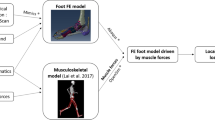Abstract
An integrative analysis, comprising radiographic imaging of the foot, plantar pressure measurements, surface electromyography (EMG) and finite element (FE) modelling of the three-dimensional (3D) foot structure, was used to determine the effects of muscular fatigue induced by intensive athletic or military marching on the structural stability of the foot and on its internal stress state during the stance phase. The medial/lateral (M/L) tendency towards instability of the foot structure during marching in fatigue conditions was experimentally characterised by measuring the M/L deviations of the foot-ground centre of pressure (COP) and correlating these data with fatigue of specific lower-limb muscles, as demonstrated by the EMG spectra. The results demonstrated accelerated fatigue of the peroneus longus muscle in marching conditions (treadmill march of 2km completed by four subjects at an approximately constant velocity of 8 kmh−1). Severe fatigue of the peroneus longus is apparently the dominant cause of lack of foot stability, which was manifested by abnormal lateral deviations of the COP during the stance phase. Under these conditions, ankle sprain injuries are likely to occur. The EMG analysis intensive marching (averaged decreases of 36% and 40% in the median frequency of their EMG signal spectra, respectively). Incorporation of this information into the 3D FE model of the foot resulted in a substantial rise in the levels of calcaneal and metatarsal stress concentrations, by 50% and 36%, respectively. This may point to the mechanism by which stress fractures develop and provide the biomechanical tools for future clinical investigations.
Similar content being viewed by others
References
Almeida, S. A., Williams, K. M., Shaffer, R. A., andBrodine, S. K. (1999): ‘Epidemiological patterns of musculoskeletal injuries and physical training’,Med. Sci. Sports Exerc.,31, pp. 1176–1182
Basmajian, J. V., andDe Luca, C. J. (1985): ‘Muscles alive’ (Williams and Wilkins, Baltimore, 1985), pp. 125–127
Bauby, C. E., andKuo, A. D. (2000): ‘Active control of lateral balance in human walking’,I. Biomech.,33, pp. 1433–1440
Brosh, T., andArcan, M. (1994): ‘Toward early detection of the tendency to stress fractures’,Clin. Biomech.,9, pp. 111–116
Cailliet, R. (1983): ‘Foot and ankle pain’ (F.A. Davis Company, Philadelphia, 1983)
De Luca, C. J. (1984): ‘Myoelectric manifestations of localized muscle fatigue in humans’,Crit. Rev. Biomed. Eng.,11, pp. 251–265
Donahue, S. W., andSharkey, N. A. (1999): ‘Strains in the metatarsals during the stance phase of gait: implications for stress fractures’,Bone Joint Surg. 81, pp. 1236–1243
Fyhrie, D. P., Milgrom, C., Hoshaw, S. J., Simkin, A., Dar, S., Drumb, D., andBurr, D. B. (1988): ‘Effect of fatiguing exercise on longitudinal bone strain as related to stress fracture in humans’,Ann. Biomed. Eng.,26, pp. 660–665
Gefen, A., Megido-Ravid, M., Itzchak, Y., andArcan, M. (2000): ‘Biomechanical analysis of the three-dimensional foot structure during gait — a basic tool for clinical applications’,J. Biomech. Eng.,122, pp. 630–639
Gefen, A., Megido-Ravid, M., andItzchak, Y. (2001): ‘In vivo biomechanical behavior of the human heel pad during the stance phase of gait’,J. Biomech.,34, pp. 1661–1665
Gefen, A., Megido-Ravid, M., Itzchak, Y., andArcan, M. (2002): ‘Analysis of muscular fatigue and foot stability during high-heeled gait’,Gait & Posture,15, pp. 56–63
Gerdle, B., andKarlsson, S. (1994): ‘The mean frequency of the EMG of the knee extensors is torque dependent both in the unfatigued and the fatigued states’,Clin. Physiol.,14, pp. 419–432
Glitsch, U., andBauman, W. (1997): ‘The three-dimensional determination of internal loads in the lower extermity’,J. Biomech.,30, pp. 1123–1131
Grimston, S. K., andZernicke, R. F. (1993): ‘Exercise-related stress response in bone’,J. Appl. Biomech.,9, pp. 2–14
Han, T. R., Paik, N. J., andIm, M. S. (1999): ‘Quantification of the path of center of pressure (COP) using an F-scan in-shoe transducer’,Gait & Posture,10, pp. 248–254
Mannion, A. F., andDolan, P. (1996): ‘Relationship between myoelectric and mechanical manifestations of fatigue in the quadriceps femoris muscle group’,Eur. J. Appl. Physiol.,74, pp. 411–419
Merletti, R., andRoy, S. (1996): ‘Myoelectric and mechanical manifestations of muscle fatigue in voluntary contractions’,J. Orthop. Sports Phys. Ther.,24, pp. 342–353
Milgrom, C., Shlamkovitch, N., Finestone, A., Eldad, A., Laor, A., Danon, Y. L., Lavie, O., Wosk, J., andSimkin, A. (1991): ‘Risk factors for lateral ankle sprain: a prospective study among military recruits’,Foot Ankle,12, pp. 26–30
Nordin, M., andFrankel, V. H. (1989): ‘Basic biomechanics of the musculoskeletal system’ (Lea & Febiger, Philadelphia, PA, 1989)
Okada, M. (1987): ‘Effect of muscle length on surface EMG wave forms in isometric contractions’,Eur. J. Appl. Physiol.,56, pp. 482–486
Perotto, A., andDelagi, E. F. (1996): ‘Anatomic guide for the electromyographer — the limbs and trunk’ (Charles C. Thomas, Springfield, IL, 1996)
Rodgers, M. M. (1995): ‘Dynamic foot biomechanics’,J. Orthop. Sports Phys. Therapy,21, pp. 306–315
Rosen, J., Fuchs, M. B., andArcan, M. (1999): ‘Performances of Hill-type and neural network muscle models — toward a myosignalbased exoskeleton’,Comput. Biomed. Res.,32, pp. 415–439
Savelberg, H. C. M., Vorstenbosch, A. T. M., Kamman, E. H., Van De Weijer, J. G. W., andSchambardt, H. C. (1998): ‘Intra-stride belt-speed variation affects treadmill locomotion’,Gait & Posture,7, pp. 26–34
Stacoff, A., Steger, S., Stussi, E., andReinschmidt, C. (1996): ‘Lateral stability in the sideward cutting movements’,Med. Sci. Sports Exerc.,28, pp. 350–358
Svantesson, U., Osterberg, U., Thomeé, R., andGrimby, G. (1998): ‘Muscle fatigue in a standing heel-rise test’,Scand. J. Rehabil. Med.,30, pp. 67–72
Thibodeau, G. A., andPatton, K. T. (1996): ‘Anatomy and physiology’ (Mosby, St. Louis)
Xiao, S., andLeung, S. C. (1997): ‘Muscle fatigue monitoring using wavelet decomposition of surface EMG’,Biomed. Sci. Instrum.,34, pp. 147–152
Winter, D. A. (1995): ‘Human balance and posture control during standing and walking’,Gait & Posture,3, pp. 193–214
Author information
Authors and Affiliations
Corresponding author
Rights and permissions
About this article
Cite this article
Gefen, A. Biomechanical analysis of fatigue-related foot injury mechanisms in athletes and recruits during intensive marching. Med. Biol. Eng. Comput. 40, 302–310 (2002). https://doi.org/10.1007/BF02344212
Received:
Accepted:
Issue Date:
DOI: https://doi.org/10.1007/BF02344212




